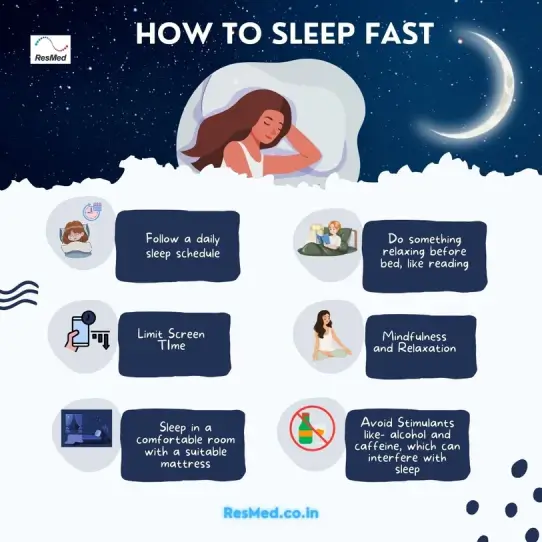Do you ever find yourself tossing and turning, staring at the clock, and wondering why you can’t fall asleep? You’re not alone falling asleep quickly can feel like a luxury. But with a few simple techniques, you can train your body to fall asleep in as little as 10, 60, or 120 seconds. Sounds magical, right? Let’s dive in!
Why Do Some People Struggle to Fall Asleep?
It usually takes a healthy adult about 10–20 minutes to fall asleep, but factors like stress, anxiety, or unhealthy habits can keep your mind active and delay sleep. Here are some common reasons sleep may elude you:
- Stress and Overthinking: Your brain refuses to “shut down” due to worries or thoughts.
- Blue Light Exposure: Devices like phones and tablets suppress melatonin production, keeping you awake.
- Irregular Sleep Schedule: Going to bed at inconsistent times confuses your internal clock.
- Uncomfortable Sleep Environment: A noisy, too-hot, or too-bright bedroom can disrupt your sleep cycle.
- Caffeine and Late-Night Snacking: Both can spike your energy levels right when you should be winding down.
Techniques to Fall Asleep Quickly

Here’s the good news: falling asleep quickly is a skill you can master with practice. Try these techniques to sleep faster in 10, 60, or 120 seconds:
1. How to Fall Asleep in 10 Seconds: The Military Method
This method, developed for military pilots, is designed to help you doze off quickly even in less-than-ideal conditions.
Steps to follow
- Relax your entire face, including your forehead, eyes, and jaw.
- Drop your shoulders and hands to the side, letting all the tension go.
- Exhale deeply, relaxing your chest.
- Release tension in your legs, thighs, and calves.
- Picture a peaceful scene, like lying in a canoe on a calm lake, for 10 seconds.
- If your mind starts racing, repeat the phrase “don’t think” for 10 seconds.
Pro tip: This method may take up to 6 weeks of consistent practice to perfect!
2. The 4-7-8 Breathing Method
This technique combines deep breathing and mindfulness to calm your nervous system.
Steps to follow:
- Place the tip of your tongue against the roof of your mouth.
- Exhale fully through your mouth, making a “whoosh” sound.
- Inhale deeply through your nose for 4 seconds.
- Hold your breath for 7 seconds.
- Exhale slowly through your mouth for 8 seconds.
- Repeat for four cycles or until you feel relaxed enough to drift off.
Note: If you have respiratory conditions like asthma, consult your doctor before trying this method.
3. Visualization and Reverse Psychology
Sometimes, your mind just won’t cooperate. These techniques can help:
A. Visualization
- Close your eyes and imagine a serene place, like a beach or a forest.
- Engage all your senses magine the sound of waves, the smell of salt air, or the feeling of soft sand.
B. Paradoxical Intention
- Try telling yourself to stay awake instead of trying to sleep.
- This reverse psychology trick reduces performance anxiety and helps your mind relax.
Tips for Long-Term Sleep Success
Falling asleep quickly starts with good sleep hygiene and lifestyle habits. Here’s what you can do:
- Stick to a Schedule: Go to bed and wake up at the same time every day, even on weekends.
- Limit Screen Time: Avoid screens for at least an hour before bed to reduce blue light exposure.
- Create a Sleep-Friendly Space: Keep your bedroom cool, quiet, and dark. Consider blackout curtains or a white noise machine.
- Watch Your Diet: Avoid caffeine and heavy meals 4–6 hours before bed.
- Wind Down: Develop a calming pre-sleep routine, such as reading, meditating, or taking a warm bath.
- Stay Active: Regular exercise can help regulate your sleep-wake cycle, but avoid vigorous activity close to bedtime.
Sleep Techniques
| Time to Fall Asleep | Technique | Key Steps |
|---|---|---|
| 10 seconds | Military Method | Relax your body, clear your mind, and visualize. |
| 60 seconds | 4-7-8 Breathing | Inhale for 4 seconds, hold for 7, exhale for 8. |
| 120 seconds | Visualization & Reverse Psychology | Imagine a calming scene or tell yourself to stay awake. |
FAQs
Q: Why does it take me so long to fall asleep?
Stress, irregular sleep schedules, and an overactive mind can all delay sleep. Try relaxation techniques to calm your body and mind.
Q: How can I train my body to fall asleep faster?
Stick to a consistent sleep schedule, create a relaxing bedtime routine, and avoid screens before bed. Over time, these habits will train your body to wind down more quickly.
Q: Does the 4-7-8 method really work?
Yes, many people find this breathing technique effective. It reduces stress, lowers your heart rate, and promotes relaxation, helping you fall asleep faster.
Q: What if none of these methods work?
If you’re still struggling with sleep, consult a doctor or sleep specialist. Persistent issues may be linked to sleep disorders like insomnia or sleep apnea.
Q: Is it okay to nap during the day?
Short naps (20–30 minutes) can boost energy, but long naps or naps too close to bedtime can interfere with your ability to fall asleep at night.
Final Thought
Falling asleep fast isn’t just about techniques, it’s about creating a lifestyle that promotes restful sleep. Whether it’s the military method, the 4-7-8 breathing technique, or visualization, consistency is key. With practice and some lifestyle adjustments, you can turn sleepless nights into a thing of the past.
References
- National Sleep Foundation: Sleep hygiene tips for better rest.
www.sleepfoundation.org - Harvard Medical School: Techniques for relaxation and improving sleep.
www.health.harvard.edu - University of Oxford Study: Effects of imagery distraction on sleep onset.
www.ox.ac.uk - National Institutes of Health: Research on breathing techniques for stress relief.
www.nih.gov


